After a difficult 2017/2018 season in which Lille replaced Marcelo Bielsa for Christophe Galtier, Les Dogues finished 17th avoiding relegation by just one point. The next transfer window they only spent under nine million euros on new players such as Jonathan Ikoné, Loïc Rémy and Jonathan Bamba. The following campaign under the guidance of Galtier, Lille finished second in Ligue 1. As a result, centre-forward Rafael Leão left to play for AC Milan and star player Nicolas Pépé transferred to Arsenal FC. This was a hard hit for Lille. But despite these losses and no huge investments, they still ended last season in fourth position.
Under Galtier, Lille have reinvented themselves and this hasn’t gone unnoticed. Many praise his tactical approach to the game. His secret to his success is largely due to the flexible 3-1-6 system he implemented at Lille.
In this tactical analysis, we will look at Galtier’s flexible 3-1-6 system and explain how he uses this system to break down the opponent and the key advantages of it.
Global understanding
Before we analyze Lille’s 3-1-6 structure we have to understand the basic idea behind this structure. The idea is simple and identical to all systems however this one differs in space occupation and consequently in the choices one would make. The idea is to manipulate the organization of the opposition in order to find space between the lines and behind the lines to create goal-scoring opportunities. So with this in mind, we have to understand the possible manipulative effects it has on the defensive structure as a consequence of the 3-1-6 structure.
For example, when a full-back is pushed up this might result in a man-oriented approach of the oppositional winger. Different wide dynamics occur when the opposition shift their block in a zonal approach. In this case, the opposing full-back might close down the receiving full-back.
Note that all movements described in this tactical analysis are decisions of the player itself. In the eyes of Borussia Mönchengladbach assistant René Maric, tactics are the sum of the players’ decisions. It all comes down to perception, decision and execution of the player, not the coach. Consequently, the 3-1-6 relies upon problem solvers and great decision-makers as the player has to come with the answer.
Building from the back
Initially, Lille start the game in a back four formation with two recognized centre-backs. The reason they don’t start in the 3-1-6 shape is because out of possession they like to press in a 4-4-2 shape. But when they build an attack, Lille change their shape to the 3-1-6 system, they will form a back three through movement. So Lille start the game with two centre-backs and a double pivot before one of the midfielders drops into a wide centre-back role, drawing a marker and an inch of space for a pass from the most central defender to the six space. Or in some cases, a full-back moves inside to create this back three. When the full-back moves inside, Lille only make use of one pivot. The player who creates the back three, a full-back moving inside or a dropping midfielder, is dependent on the opposition and the profile of the player. Besides the three centre-backs, the 3+1 consists of one midfielder in front of them. Mostly it is Renato Sanches who plays as the pivot behind the first line press to manipulate the second line press. In the image below shows this situation in the 3+1 structure. Valencia CF defends in a flat 4-4-2 shape.
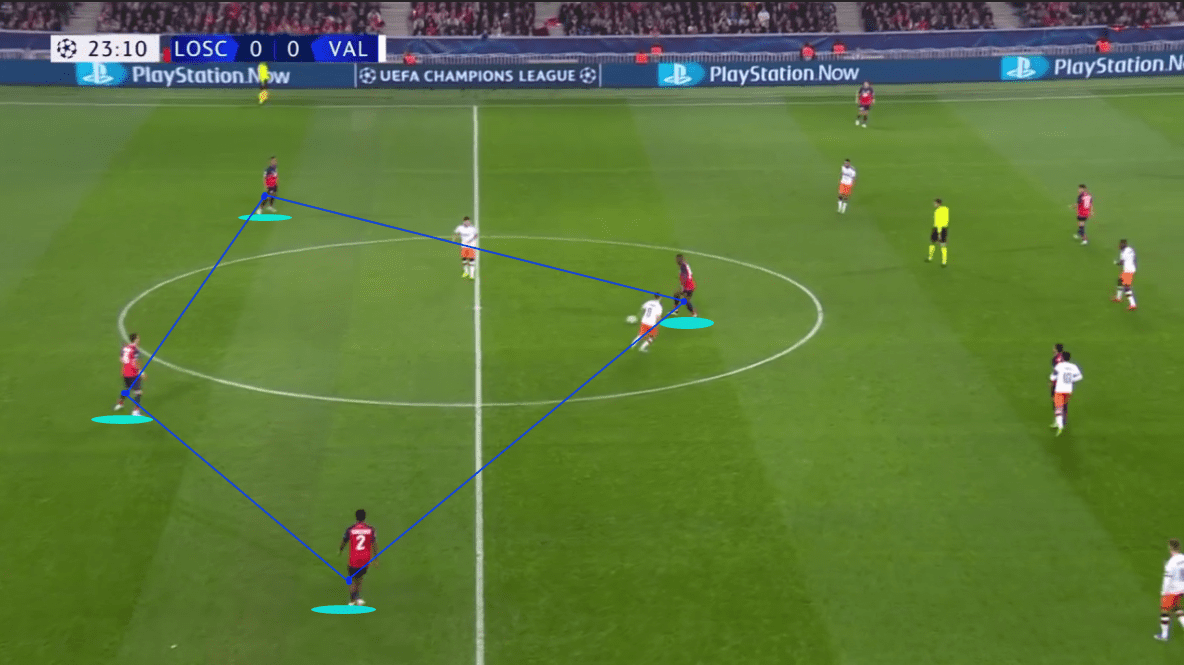
The 3+1 structure exists in a newly formed, staggered line of 3 centre backs. This staggering consists of the outside centre-backs stepping forward which forms a diamond shape with the pivot. But this shape can also be formed by the goalkeeper and the three players forming the back three. In the case below José Fonte pushes further up the field to create optimal distances during the build-up phase. This structure also relies on a goalkeeper having good distribution to play his way out of a high press. This is a huge advantage when building an attack and keeping the ball. As Lille have Mike Maignan, it is safe to say they have a goalkeeper they can rely on.
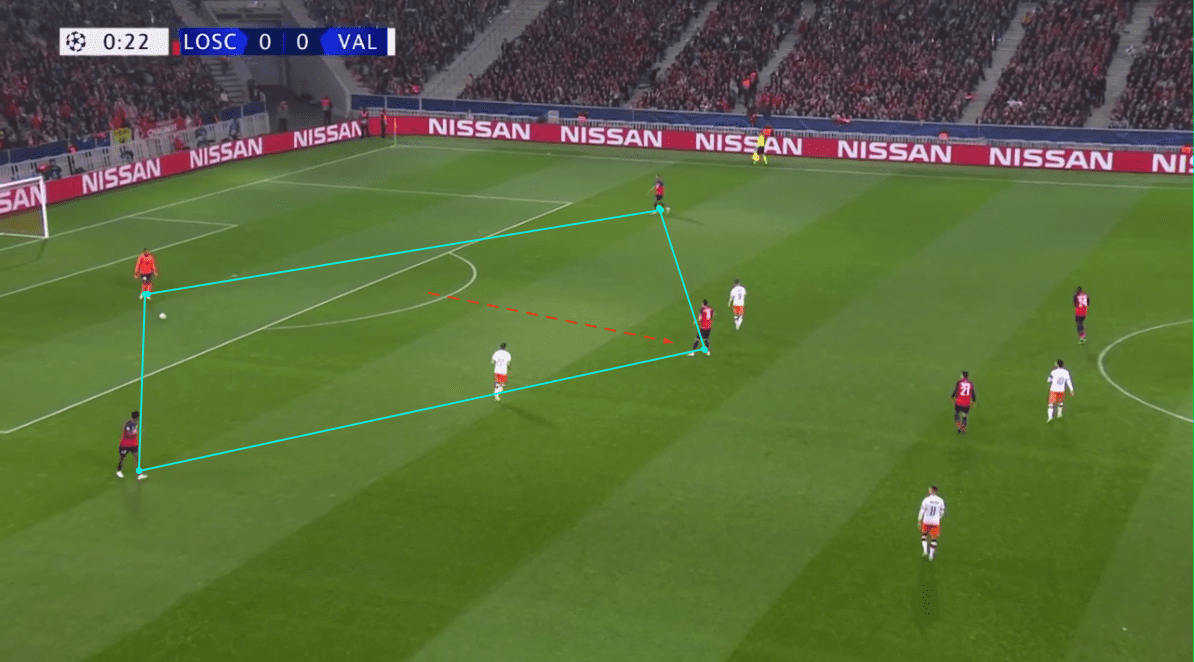
By forming this diamond structure there are a few advantages. Firstly this opens up better passing angles to the full-backs. Secondly, the higher positioning engages the second line to press the centre back on the ball. This opens up space between the opponent’s lines and opens up vertical passing lanes. Therefore optimal distances between each centre-back are required, to indeed provoke this second line press. Lastly, the staggered and higher position of the wide centre-backs increases the chance to prevent a counter-attack as the wide centre-backs are in a better position to counter-press. The idea of stopping the counter-attack is derived from the inverted wing-backs which were introduced by Pep Guardiola.
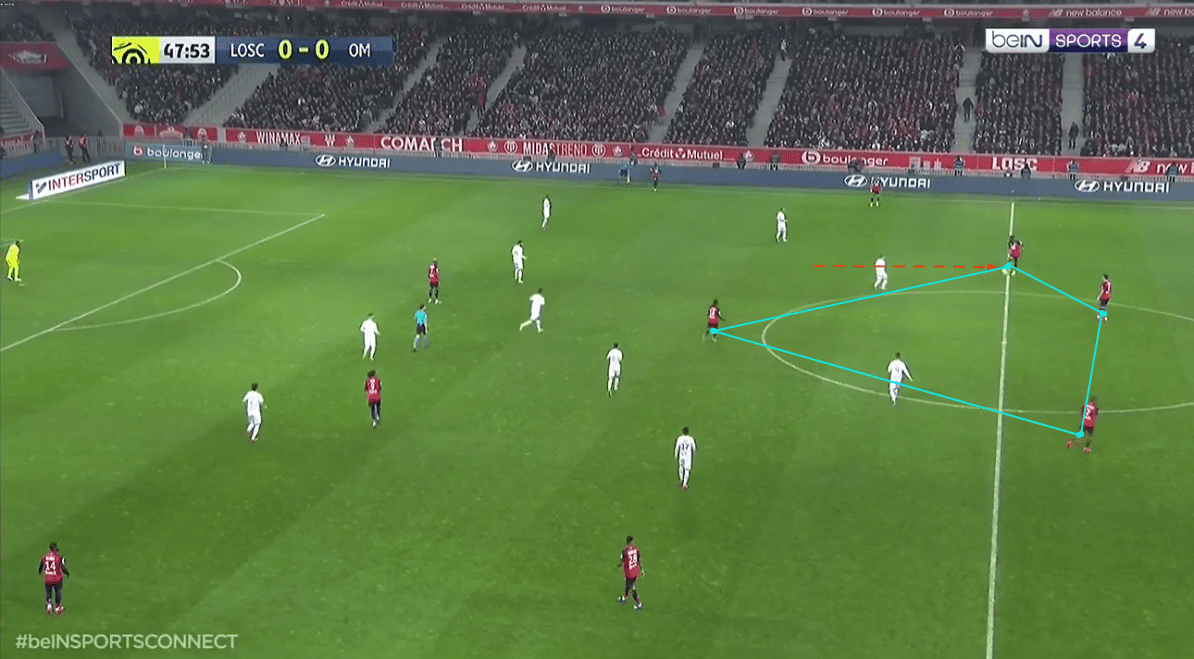
Besides provoking the opposition to press and opening up passing lanes, the 3+1 structure looks to create a numerical superiority against the first line of pressure of the opponent. With this structure, it is difficult for the opponent to commit men forward to press. Keeping in mind there are six players occupying the second and third line of the opponent.
As stated above, in front of the back three, one deep-lying midfielder floats to act as the connection between the line of three defenders and the six attackers. The movement of the midfielder, Renato Sanches, provokes the opposition’s second line to press and step out. This creates space between the lines and opens up vertical passing lanes.
The image below illustrates this situation. Space occurs when the central centre-back plays a pass into a midfielder and the midfielder lays off the ball to a wide centre-back. This is also known as a wall pass. As the midfielder has his back to the opposition, he provokes a pressing trigger in the opposition. Consequently, the ball is played back to the centre-back, he receives the ball and has now the option to play forward in the space the opponents’ midfielder has left. Because of this Galtier’s asks his team to build an attack patiently and wait for the opponent to make a mistake.
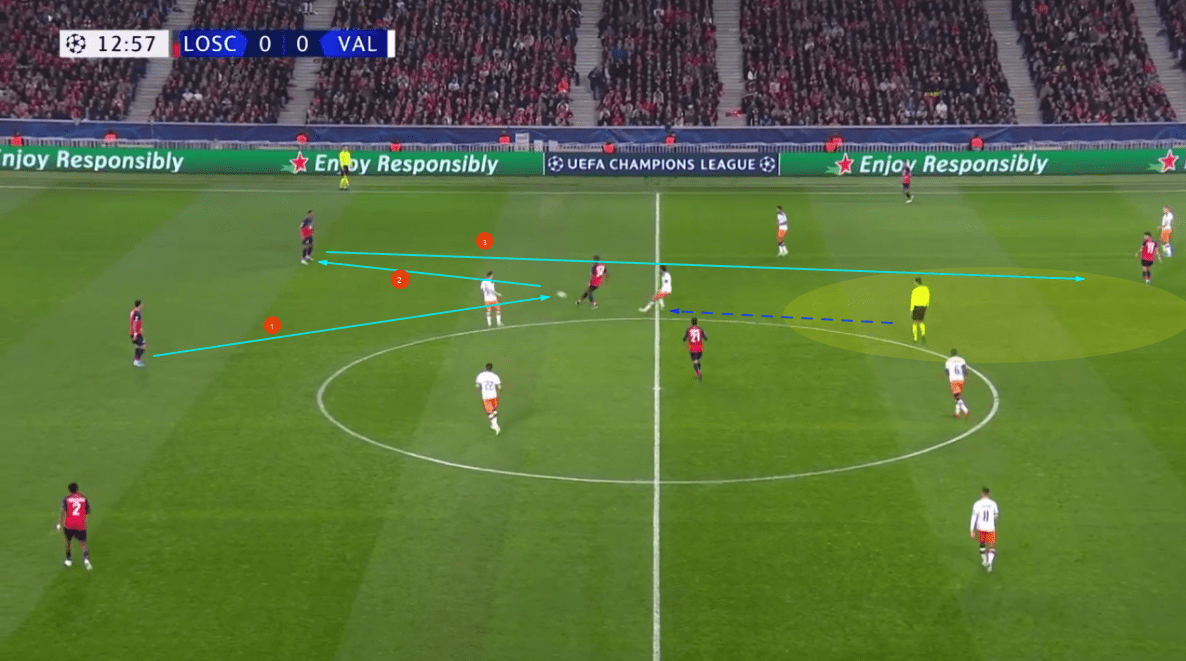
The opponent won’t always allow Lille to build patiently without pressure. At times they will be pressed high up the pitch, in a man-marking pressing system. Although a man-marking system is difficult to apply against a 3-1-6 system, we will discuss why later on. There are teams that press like this because it is less likely to cause confusion between each pressing player. This makes it difficult for Lille to progress play. The flexibility to combat the man orientation comes through a dropping midfielder from between the lines, creating a double pivot in a 3+2 structure. Preferably in a staggered position relative to the other pivot. This creates diagonal passing options and increases one-touch play.
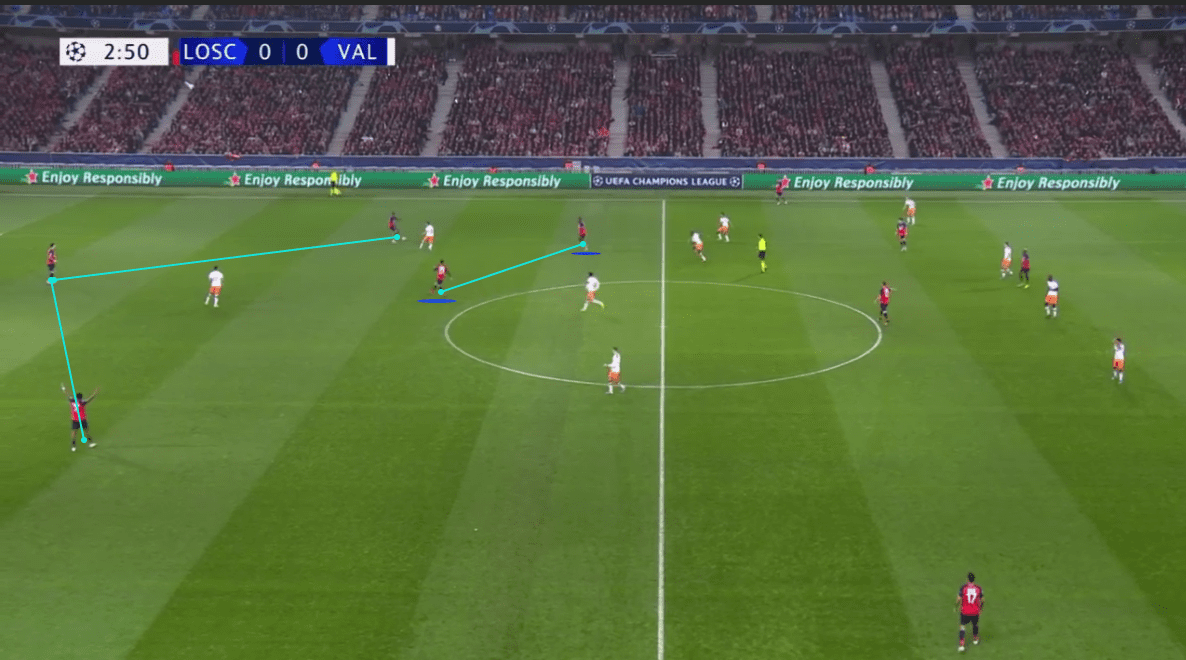
The positions of the four attackers
Above we discussed the key players who build the attack. Now we will discuss the four players higher up the field. So, with the four attackers remaining to position themselves in between the second and third line of the opposition, it makes it difficult for the opposition line to push up and keep a compact block. As discussed earlier, not many teams press high up against this system. One of the reasons is because four players occupy the space between the defensive and midfield line. When building in a 3-1-6 and one of the opponent’s second line steps out to pressurize the build-up, it opens up passing options between the lines for the ball carrying defenders. This means the last line is pinned and dependent on the movement of Lille’s front players.
The positions of the four attacking players between the lines can be divided into two different concepts.
The first one is that the central zone is split in half and as a consequence, the pitch is divided into two central and two half-space vertical lanes. Consequently, every vertical lane is occupied by one player. Which means that there are four players occupying the space between the second and third line of the opposition. The occupation of the space between the lines in every vertical central lane creates a four versus four situation once the ball is played between the lines. Or in the case when playing against a back three, there arises a numerical superiority in the form of a four versus three situation.
But the main focus is not only to create an overload between the lines. It is more so that the line of attackers should drop deep after taking up a higher position. This causes confusion through the opposition’s defensive block. the aim is to regularly drop deep and push forward again to manipulate the opposition defensive block. The below image shows how the opposition’s last line is occupied by four Lille attackers and the midfield/last line is stretched by the two full-backs. In this case, FC Toulouse keeps their block very compact, which doesn’t give the pivot Sanches or the centre-backs many passing options to play into the Toulouse block. In order to create space, Jonathan Bamba drops on the ball-far side from his position between the lines. This not only makes him available for a pass but also provokes the Toulouse midfielder to step out and press, which creates space in behind to exploit. These constant dropping movements from the players between the lines focus on getting the opposition to react and follow. In this situation, a wall pass is played and opens up space between the lines that a deeper-lying player exploits with a penetrating pass.
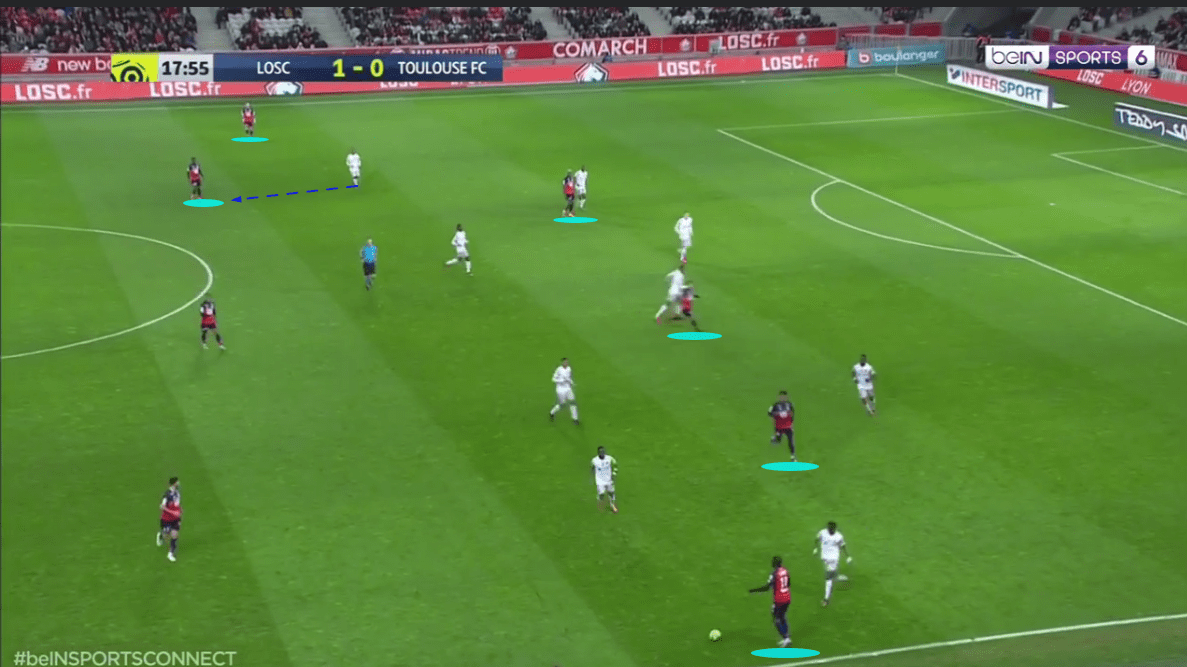
The other concept is overloading the half-space area. In this case, Galtier asks his front four to occupy the halfspaces in order to overload these areas. The idea is to pin the last line with only two strikers by positioning them between the full-backs and centre-backs. By placing the strikers in the gaps between the centre-backs and full-backs, the strikers occupy all the defenders in the opposition’s backline. Consequently, the centre-backs have to mark both strikers and the full-backs are reluctant to step out of the backline because doing so will create space in the channel for the pace of the two strikers to exploit.
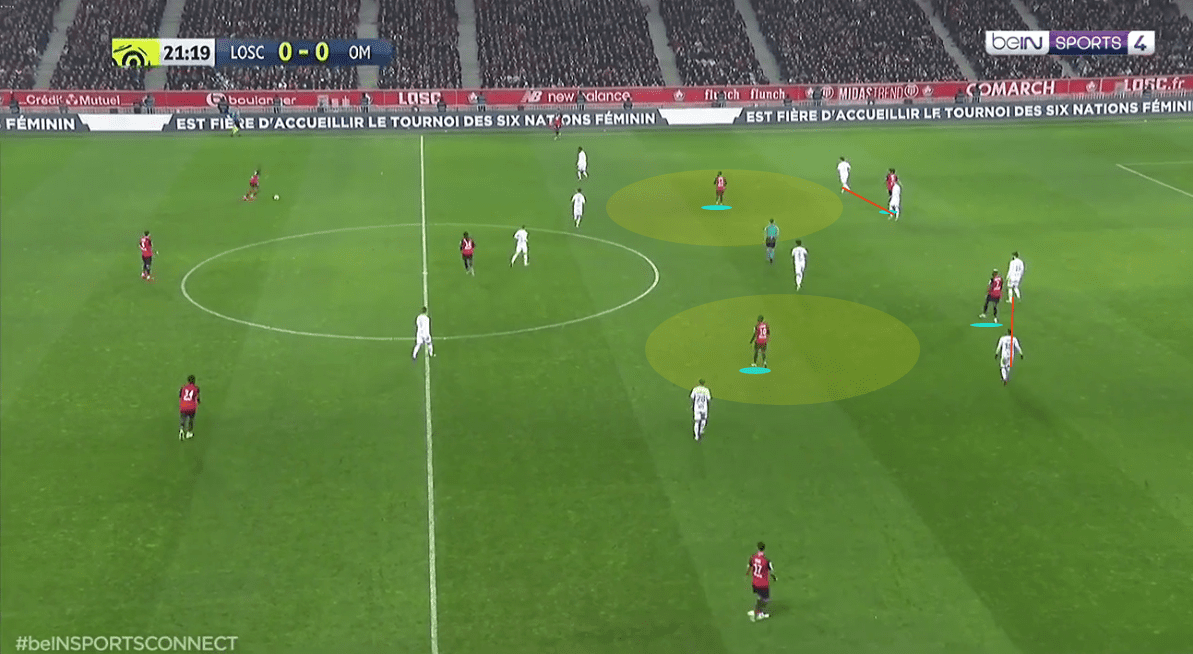
The positioning of the wingers, who moved inside, is in front of the strikers. Making sure they position themselves on outer side/shoulder of the oppositional central-midfielder, trying to receive with space. At first sight, this doesn’t seem effective because the wingers block the passing lanes to the strikers. Giving the centre-backs on the ball fewer options to pass to. However, the concept doesn’t rely on providing as many passing options as possible but looks to create free space for the wingers. The combination of the back three engaging the second line press and the two strikers pinning the backline creates space between the lines for the wingers to receive. So the wingers try to receive in the half-space and this also facilitates the wingers to receive with open body shape. The image below shows the wingers move inside to block to overload the half-spaces.
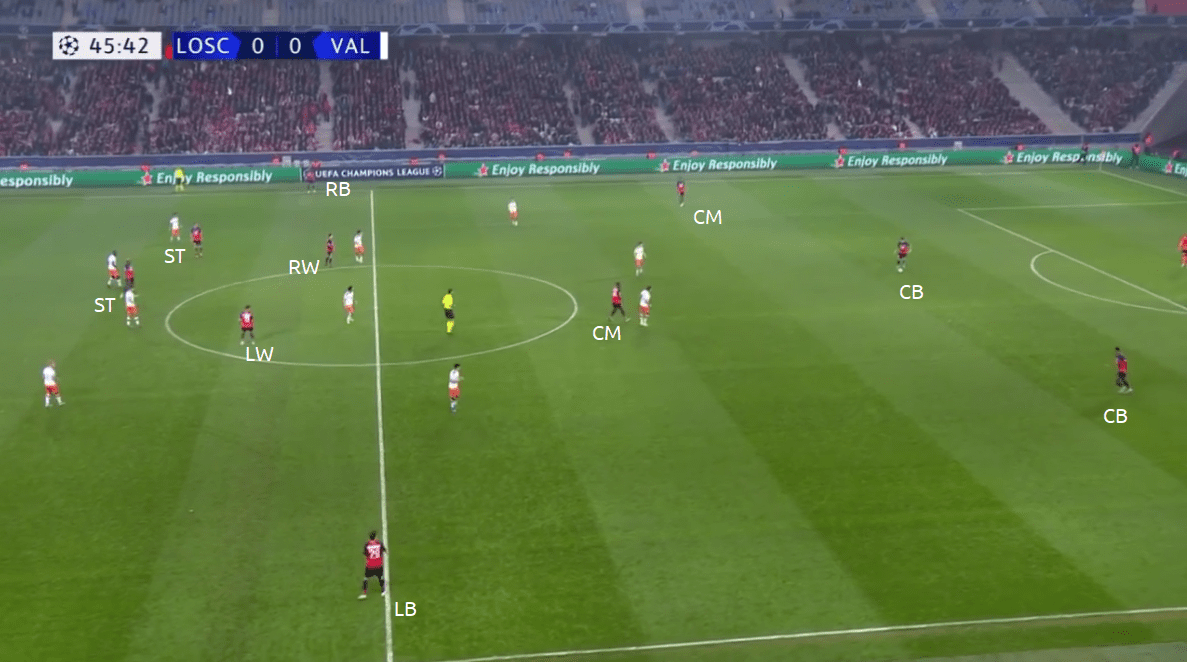
Another image below illustrates the average positions of every Lille player during the Champions League encounter between Lille and Valencia CF. In this game, Galtier applied the 3-1-6 structure with the overloads in the half-spaces as we can see below.
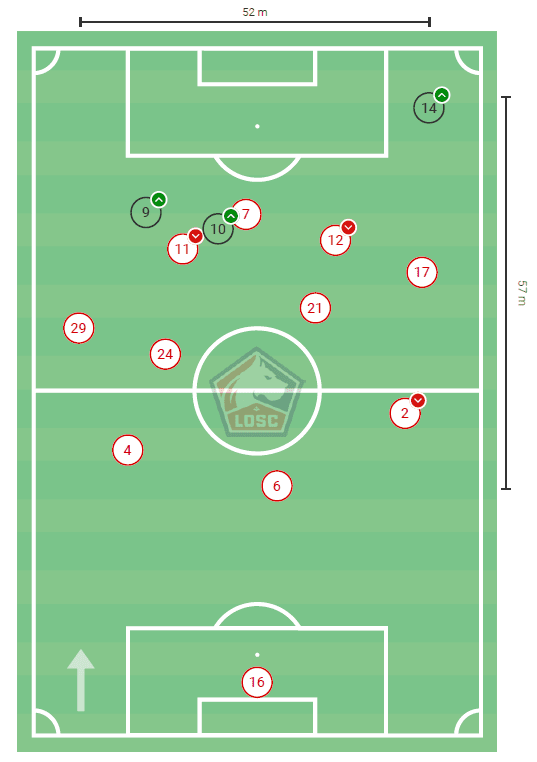
So this concept looks to free up the inside winger between the lines. Another way Galtier isolates the winger between the lines is through dummy runs and third man combinations. In the below image we can see how the passing lane to Bamba between the lines opens up. But the backline pushed up, allowing him no space to turn. This moment is when Galtier asks the striker, in this case, Loic Remy to perform a dummy run to the side. This pulls out the opponents centre-back and causes hesitation for the full-back to follow through on Bamba, who is about to receive, the ball or to stay and cover Remy’s run. As a consequence of Remy’s movement, space opens up centrally and gives Bamba the chance to exploit the newly opened space. To conclude, the movement of the striker is effective because of the various and unpredictable options it gives the winger between the lines. Bamba could play a third man combination to Remy after the pass from Reinaldo. Or Bamba could turn into space opened up behind him.
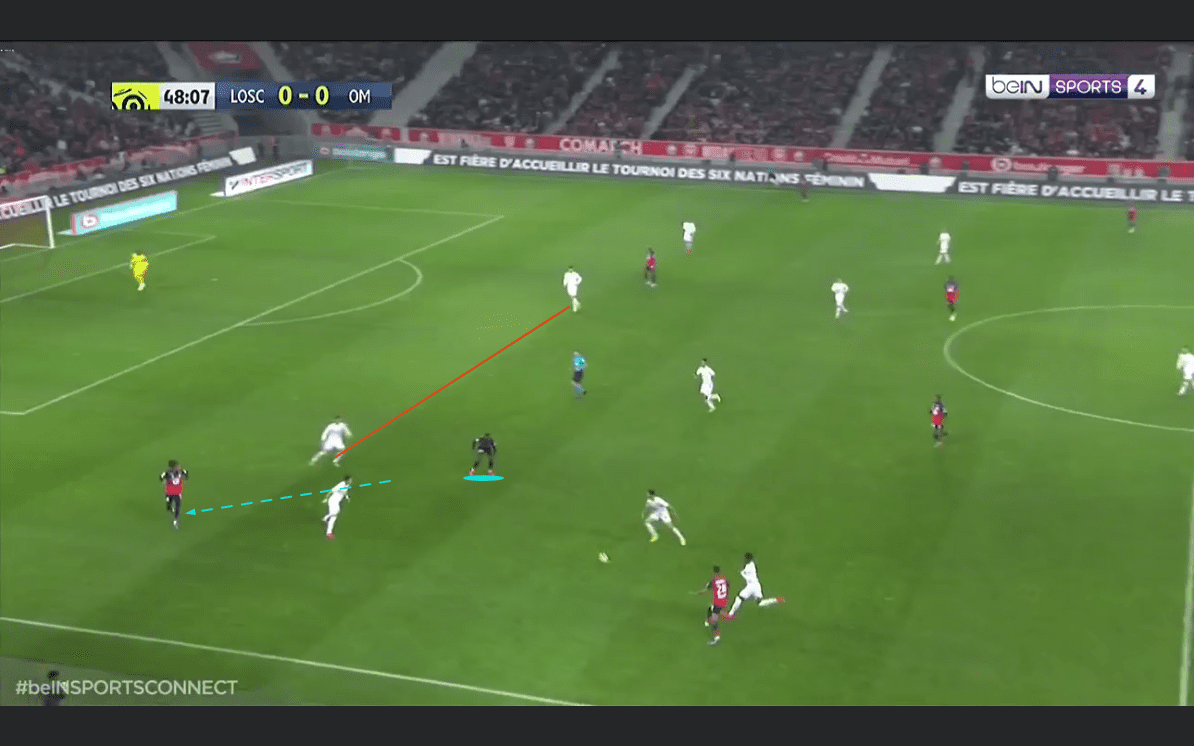
The role of the full-backs
The 3-1-6 structure aims to progress play through the middle as each outside vertical lane is only occupied by one player. But because every team without the ball reduces the space down the middle. It’s not always possible to find a way through the middle. As a decoy to find the space through the middle, Lille pass the ball to the outside. As we can see below, once the ball is played to the outside the opposition’s full-back steps out. This creates space behind the full-back which the centre-forward looks to exploit. In order to not leave the centre unoccupied, the centre-back stays central and the centre-midfielder follows the centre-forward. These wide dynamics provide space for the winger to drop into. Now they can exploit the space that opens up down the middle by playing the pass to the free winger, because of the wide overload they created.
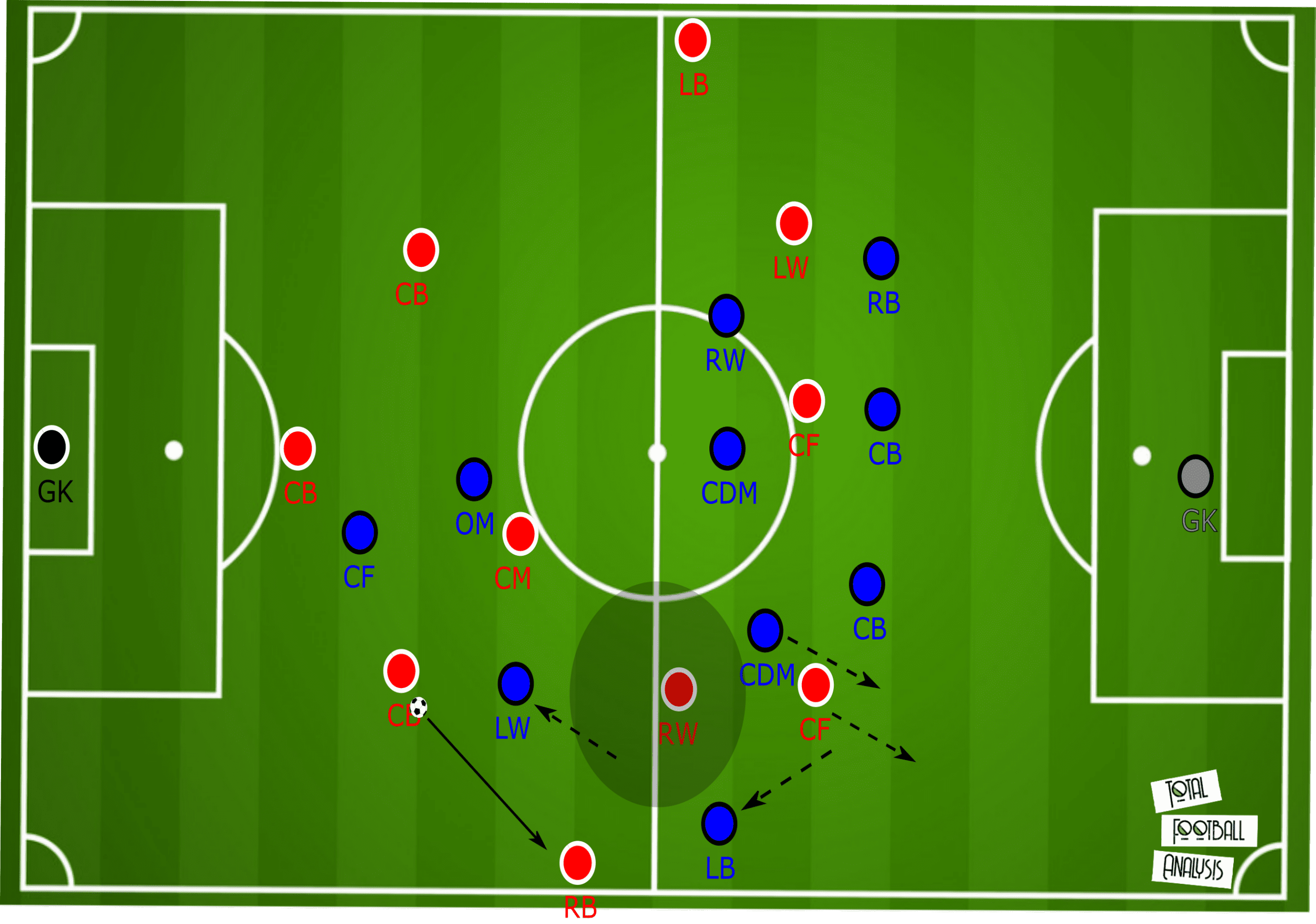
Other than playing as a decoy when Lille are trying to find space through the middle. The full-backs have the task to provide width during the possession phase. The positioning is key, moving deep enough to be available for a pass from the wide centre-backs but staying high enough to stretch the midfield or even backline. Then the ability to make runs in behind and deliver crosses is also important. As the centre of the field is so packed with players. The full-backs are isolated down the touchline. Because of this isolation, it would be an additional positive skill if the full-backs were able to dominate in 1vs1 situations. But timing a run in behind can compensate for this.
Conclusion
After analyzing Lille’s 3-1-6 system in this tactical analysis, it appears that this system relies on the players recognizing space and making the right choice to take advantage of the space that opens up. Shortly said, the players filling in this system have to be good decision-makers. As a consequence, the 3-1-6 system stimulates its players to be creative.
The main aim of the system can be found in a famous quote Manchester City manager Guardiola. Guardiola once said: ‘the aim is to move the opponent and not the ball.’ This is applicable to the system as the aim is to manipulate the opponents’ defensive structure through movement.
The key to success is to avoid the opponent pressing in a man orientated way. If the press is zonal, there is always a numerical superiority during build-up play in the deeper areas. In addition to that, the opposition is pinned back due to the high number of players occupying the space between the lines. On the other hand, this setup gives a good chance to prevent any counter-attack because of the positioning of wide the centre-backs and the pivot in front of them. After taking into consideration the advantages the 3-1-6 system gives, it is no coincidence that teams like AFC Ajax and FC Bayern München also use this system.





Comments